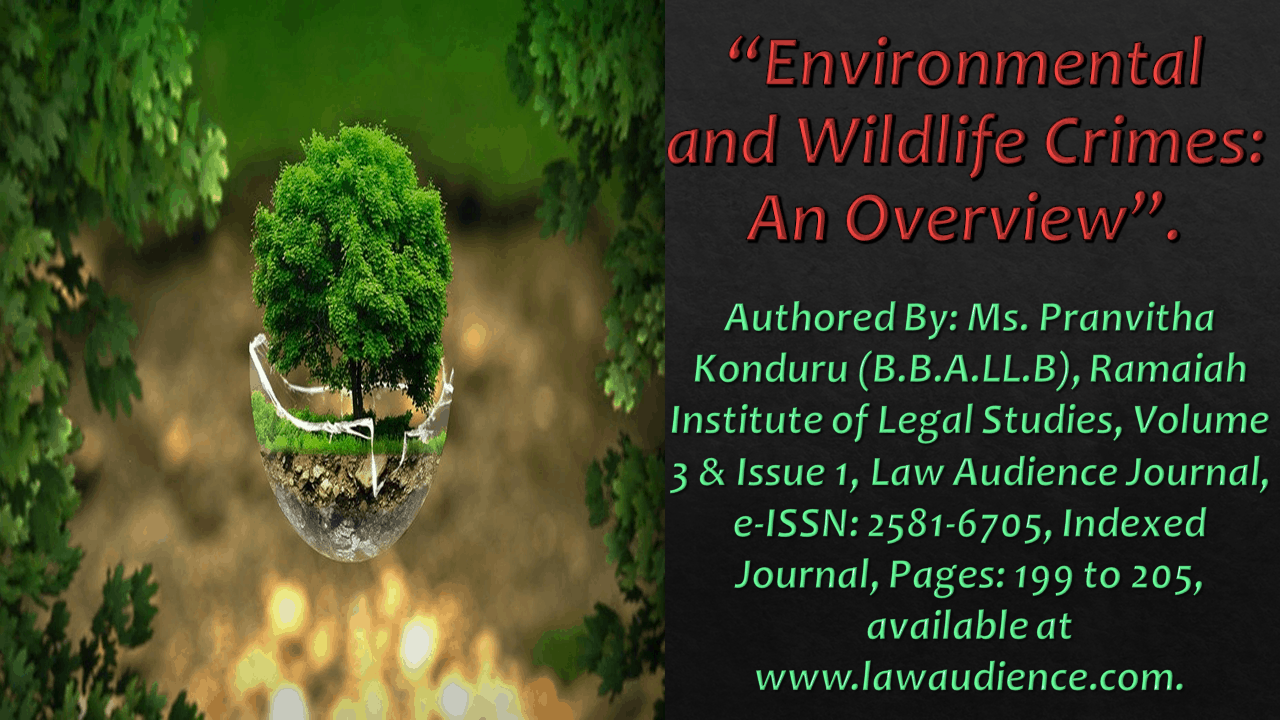Click here to download the full paper (PDF)
Authored By: Ms. Pranvitha Konduru (B.B.A.LL.B), Ramaiah Institute of Legal Studies,
Click here for Copyright Policy.
“Crimes committed by human beings not only cause damage to other humans but they also cause damage to the environment and wildlife around us. It is the fourth largest area of crime in the list of crimes”.
I. ENVIRONMENTAL CRIMES:
National Crime Records Bureau (hereinafter referred to as NCRB) defines an environmental crime which includes violations under five laws namely, The Indian Forest Act, 1927, Wildlife Protection Act, 1972, Environment Protection Act, 1986, Air (Prevention and Control of Pollution) Act, 1981 and Water (Prevention and Control of Pollution) Act, 1974. These crimes are either committed by individual persons or by the public. These are also committed by companies. Companies are so involved in making profits they don’t see the impact of their activities. In the same way, even, the general public is not aware of the damages caused by their activities.
These crimes cause damage to the environment and also affect the biological conditions of an area which leads to loss of lives and property as well. An environmental crime in one country may not be considered as an environmental crime in another country. This depends on the perspective of the country as to how they view a particular activity[1].
Experts held the NCRB data has under-reporting and also the inadequate covering of laws whose contravention leads to environment-related offences. In the year 2014, Rajasthan reported for half of the environmental crimes committed[2]. It was held that the local people are responsible for such acts because of their too much dependence on forests. And the Pollution Control Boards were introduced in the year 1970’s. They don’t have adequate officers and mechanisms for complaints. According to an article[3] we can understand that in the year 2016 Maharashtra stands the top in the list of states violating the provisions of the Environment Protection Act, 1986.
According to the report, 97 out of 120 violations were in Maharashtra and it recorded 170 environment-related offences. Satish Gavai, Additional-Chief-Secretary to the State Environment Department held in Hindustan Times “we are regularly filing cases of environment violations”. This article has also stated that the environmental-related offences were on the decline from 2014 to 2017.
Rajasthan reported zero cases and Uttar Pradesh reported only eleven cases under the Environmental Protection Act, 1986. There were 5835, 5156, 4732 in the years 2014, 2015 and 2016 under the Environmental-related offences. This shows a steady decline. In 2016, 8365 people were arrested for committing such offences. But regarding this, an activist and president of National Green Tribunal Bar Association held that there is Gross-Under reporting and they hide more than they reveal. It has also been stated that the Police officers and the pollution board are not having sufficient knowledge regarding how to take actions against the environmental crimes.
In 2019, 34,671 crimes related to the environment were recorded. With respect to police investigation, 7000 cases were pending and with respect to trials in the court, 50,000 cases were pending. Ishan Kukreti reported on forests and wildlife by saying that we have a long way to go when it comes to dealing with environmental crimes. He added by saying that the courts have to dispose of 137 cases every day to clear the pending cases within a year. Under environmental and pollution laws the court could dispose of only 86 cases in 2019. At this rate, it could easily take 20 years for courts to clear all the cases[4].
I.I MAJOR ENVIRONMENTAL CRIMES:
I.I.I Indiscriminate Logging:
According to the Brazilian government, the destruction of the Amazon, which is the largest rainforest in the world, led to a rise in 29% of deforestation. Logging to get wood for furniture or for other purposes leads to serious causes of environmental crime.
I.I.II Wild Animal Trafficking:
This is the third-largest illegal business in the world. This refers to non-domesticated animals or plants which are taken away from their natural environment and are put under controlled conditions either as living or their body parts. It not only means the sale of animals but also includes the sale of ivory of elephants in the black market. Wildlife trafficking is one of the rapidly expanding demands for a variety of products like coats made of fur, accessories etc. This is a serious conservation problem and has a bad effect on the population of wildlife.
I.I.III Finning:
This involves capturing millions of sharks by ships and having their fins cut alive and then they are thrown back into the water. This leads to painless death of the sharks. In the Asian market, the cost of fins is worth 600 euros. This activity has been banned in European Union since 2003. Survival of the sharks is essential because these play a major role in the trophic chain in the oceans.
I.I.IV Electronic Waste Mismanagement:
There is 50 million of electronic waste every year in the developed countries and this is exported to India, China etc. Countries like European Union have banned such activity. But such dumping leads to causing pollution in the remote areas. This electronic waste includes computers, appliances, mobile phones etc. Such pollution can be prevented by bringing up recycling measures so they don’t end up polluting the country.
I.I.V Dumping in Rivers:
This is mainly caused by companies and factories. In such cases, the waste from the factories is usually dumped into the lakes and rivers which affects fauna and this water flows to the soil. This leads to affecting flora as well. All this process affects the food chain. Using a sewage collector helps to avoid such dumping.
II. WILDLIFE CRIMES:
Wildlife crimes include taking protected plants, poaching, illegal use of poisons etc. These crimes are a part of environmental crimes. These crimes affect both flora and fauna. This includes taking, possession or trade of animals and plants against the legislations[5]. 77% of wildlife crimes in India were recorded in the states Uttar Pradesh, Rajasthan and Maharashtra[6].
Over past years, humans faced a number of zoonotic diseases like Ebola, H1N1 and now COVID-19. There is significant evidence that humans are susceptible to transmission of diseases from wildlife[7]. This article also provided information regarding the government programs to protect wildlife. They enacted the Wildlife (Protection) Act, 1972, to protect animals and birds and to maintain ecological balance in the country. This Act was amended in January 2003 by which the punishments were made more stringent. The Wildlife Protection Bill was also passed in the year 2013. All illegal activities related to animals and birds which are specified in schedules are punishable with imprisonment and a fine. The government also established a Wildlife Crime Control Bureau to coordinate efforts and actions for investigation of wildlife crimes. The wildlife Justice commission held that proper investigation and evidence could help reduce wildlife crimes and illegal trade in the country. According to an article[8] We can understand that there is an increase in animal abuses in India. Like humans, even the wildlife has the right to live. It is the duty of the citizens to take measures for the protection of the wildlife. There is a drastic increase in wildlife crimes because of poor and corrupt systems. The punishment for animal abuse is just 50/-.
The person who abuses animals can get out of it by just paying 50 rupees. Maharashtra recorded over 33 offences under Wildlife Protection Act, 1972. According to FIAPO (Federation of Indian Animal Protection Organisations) and ACGS (All Creatures Great and Small), 4,93,910 animals were the result of crimes committed by humans. Most of these cases go unreported. There was an incident where a pregnant elephant had eaten firecrackers which resulted in its death[9]. But there was no further information regarding the punishment to that offender. This is the situation in our country.
According to the PCA which stands for Prevention of Cruelty to Animals Act, 1960, it held punishment for the offenders who commit animal abuses. This shall be fined not less than ten rupees to fifty rupees for the first offence and it shall be not less than twenty-five rupees for the offence committed within three years from the date of first offence and it shall also include imprisonment. Despite so many laws and punishments, animal abuses have been increasing in India. Maneka Gandhi says that nothing matters to the people in the government. The only way to reduce such crimes is in the hands of the people. Discussions can be held by people to bring in best practices which can replace cruelty of the animals. The next serious issue is cattle and dogs. We can see many strays on the road creating havoc. Many dogs are abandoned by their owners and we can also see many animals munching away on the plastic. All these can be avoided by starting NGOs and veterinary clinics.
II.I Regulation of Wildlife Trade in India[10]:
India made a strong and legal framework to restrict wildlife trade in India. This includes the prohibition of 1800 species from wildlife trade under the Wildlife Protection Act, 1972. India is also a member of CITES (the Convention on International Trade in Endangered Species of Wild Fauna and Flora). This is an agreement to ensure where the trade of wildlife does not affect their survival.
III. IMPACTS ON THE SOCIETY:
Society at large is affected by such crimes. However, there are many legal enforcements to control such crimes. But the people who are uneducated are involved in such activities. Poor children who are uneducated are involved in such activities like poaching. So, this has a serious effect on such children. It becomes difficult for a particular nation to control such crimes because it involves punishment for children.
These activities lead to the exploitation of natural resources which deprives people of their basic needs. And this also led to diseases which are harmful to society at large. It also affects tourism because of the lack of resources in the country.
A UN Environment study held[11], that there is a rapid increase in such crimes because of various reasons like lack of awareness, lack of legislations, lack of data, lack of cooperation of national and international authorities. All such gaps can be reduced by amending the programs relating to environmental crimes. Even the UN is helping countries to adopt environmental laws and also helping with the compliance of the same. The UN has collaborated with African Prosecutors Associations for educating and training the police and prosecutors regarding environmental crimes. This is to improve their capacity to investigate such offences. Such gaps can only be filled when there is cooperation from police officers. All these crimes affect the environment and create damages to the environment which in return harms the society at large.
IV. CONCLUSION:
These crimes are a threat to peace and sustainable development. These affect food, health and economies. The environment provides fresh and clean water, air, and food which is important for both physical and mental well-being. Jobs and livelihood are also provided by the resources from nature. But our environment is under great threat because of the increase of such crimes. As stated earlier, these crimes include deforestation, dumping of waste, damage to fisheries etc. All such activities lead to polluting air, water and soil. Which in turn causes damage to the ecosystem.
So, it is the duty of every citizen to protect the environment. This can be done with the cooperation of the government. All such crimes can be erased when there is support from the government and the people doing their part to the society. Much stricter laws must be complied with. Like a coin has 2 sides, all the acts done by humans have both positive and negative impact on the society. These crimes can be controlled when people try to avoid causing a negative impact on the society and they must also try not to cause any harm to the wildlife. The environment gives a lot to the people.
So, it’s the duty of the people to give it back to the environment. This can be done by taking adequate measures and by not causing damage to the environment and wildlife.
Footnotes:
[1] Aniketh Vashishth, Environmental and wildlife crimes, LAW TIMES JOURNAL( Oct.11, 2020), https://lawtimesjournal.in/environmental-and-wildlife-crimes/#:~:text=Environmental%20and%20wildlife%20crimes%201%20Environmental%20crimes.%20These,5%20Conclusion.%20…%206%20Frequently%20Asked%20Questions.%20.
[2] Ragini Bhuyan, The gap in environmental crime statistics, MINT, (Dec.26, 2015), https://www.livemint.com/Opinion/aE8vmBDeBKOJCODKhBwctN/The-gap-in-environmental-crime-statistics.html.
[3] Jaydeep Hardikar, Environment crimes show decline, MONGABAY, Jan.5, 2018.
[4] DTE Staff, Environment crime cases piling up, disposal slow, DOWN TO EARTH( Feb. 24, 2021),https://www.downtoearth.org.in/blog/wildlife-biodiversity/state-of-india-s-environment-environmental-crime-cases-piling-up-disposal-slow-75655.
[5] Aniketh Vashishth, supra note 1.
[6] DTF Staff, supra note 4.
[7] Shankhar Prakash, It is time to rethink the wildlife crimes and its data, CONSERVATION INDIA (June 10, 2020), https://www.conservationindia.org/articles/is-it-time-to-rethink-wildlife-crime-and-its-data-in-india.
[8] Shelly Ahmed, why animal abuse cases become top in crimes of India, HYDERABAD NEWS, March 25, 2021.
[9] India outrage after pregnant elephant dies eating ‘firecracker fruit’, available at https://www.bbc.com/news/world-asia-india-52918603.
[10] Anonymous, Sources of wildlife crimes in India, JOURNALS OF INDIA (Jan.5, 2021), https://journalsofindia.com/status-of-wildlife-crime-in-india/.
[11] The Environmental Crime Crisis, available at https://www.cbd.int/financial/monterreytradetech/unep-illegaltrade.pdf.
Cite this article as:
Ms. Pranvitha Konduru, Environmental and Wildlife Crimes: An Overview, Vol.3 & Issue 1, Law Audience Journal, Pages 199 to 205 (23rd June 2021), available at https://www.lawaudience.com/environmental-and-wildlife-crimes-an-overview/.



